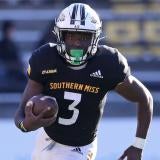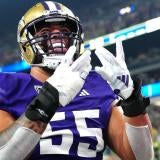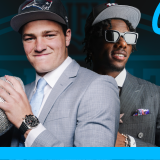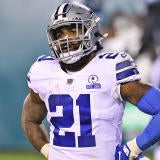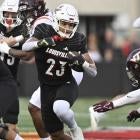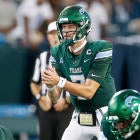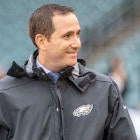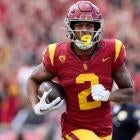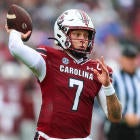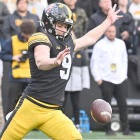The Minnesota Vikings and Adrian Peterson are currently at a stalemate. Peterson wants out of Minnesota while the Vikings have no plans to trade or release him at this time.
Much of the 2012 NFL MVP’s displeasure reportedly is with team executive Kevin Warren, who was promoted from general counsel to chief operating officer in February. Peterson is under the impression that Warren was working behind the scenes with the NFL to keep him off the field for the rest of the 2014 season after he went on the Exempt/Commissioner’s Permission List because of child abuse charges. Peterson is still eligible for reinstatement from his suspension on April 15 according to NFL Commissioner Roger Goodell despite appealing the league’s discipline of him.
It’s conceivable the Vikings could reconsider their position before the NFL Draft starts on April 30. Assuming the Vikings have a change of heart, the optimal time for a Peterson trade would be shortly before the draft so 2015 draft picks could be involved in the transaction. There are multiple variables that must fall into place for a deal to take place.
What you need to know about AP's contract
The six-year, $85.28 million contract extension containing $36 million in guarantees (with a 2017 base salary escalator worth up to $4 million) Peterson signed in 2011 is an outlier among running back contracts. Peterson has three years (2015 through 2017) remaining on his deal for $46 million. His base salaries in 2015, 2016 and 2017 are $12.75 million, $14.75 million and $17.75 million. There is also $250,000 in each of these years called “Off-Season Participation And Reporting Compensation” in Peterson’s contract for participating in all mini-camps, all organized team practice activities and reporting to training camp on time in the applicable year. Peterson has the highest 2015 cap number for running back at $15.4 million ($13 million salary and $2.4 million of signing bonus proration).
There have been three deals signed this offseason by Marshawn Lynch, LeSean McCoy and DeMarco Murray that define the upper end of the running back market. These deals are outlined in the following chart.
| Highest-paid running backs | |||||||
| Name | Club | Contract Guarantees | 2015 Salary | 2015-2016 Salary | 2015-2017 Salary | Average Salary | Contract Length |
| Marshawn Lynch | Seahawks | $12,000,000 | $12,000,000 | $21,000,000 | $31,000,000 | $12,000,000 | 2-Yr Extension |
| LeSean McCoy | Bills | $26,550,000 | $16,000,000 | $21,050,000 | $27,300,000 | $8,010,000 | 5 Years |
| DeMarco Murray | Eagles | $21,000,000 | $9,000,000 | $16,000,000 | $24,000,000 | $8,000,000 | 5 Years |
| Base salary escalators push the maximum value of Murray's deal to $42M | |||||||
The $46 million in the three remaining years of Peterson’s contract is almost 50 percent more than the money Lynch, the NFL’s second highest paid running back (by average yearly salary), will receive if he plays the three years in his new deal. The remainder of Peterson’s contract is also more than the total value of McCoy's and Murray’s five-year contracts respectively.
It’s unlikely that any team is going to be interested in taking on Peterson’s existing contract given it doesn’t bear much relation to the rest of the running back market. If Peterson is intent on leaving Minnesota, he’ll probably have to renegotiate his contract so that it is more reflective of the running back marketplace.
Examining trade compensation benchmarks
The days of teams receiving a huge bounty for a running back in a trade are long gone. ESPN’s Bill Polian, who was recently elected to the Pro Football Hall of Fame because of his distinguished career as the architect of three NFL franchises, has recommended that the Vikings insist on two first round picks for Peterson. These demands would be unrealistic especially for a running back that just turned 30.
The recent history of running back trades suggests that the Vikings should reasonably expect a second round pick at the most for Peterson. Taking on Peterson’s hefty contract factors into the type of compensation a team would be willing to give up in a trade. There’s only been one running back traded in recent years for a first round pick. The Cleveland Browns received a 2014 first round pick (26th overall) from the Indianapolis Colts for Trent Richardson, the 2012 third overall pick, early in the 2013 season. Richardson was 23 years old and considered as a potential workhorse running back when dealt, which has been proven to be false.
The only trade of a running back who had already turned 30 in recent years is Darren Sproles going from the New Orleans Saints to the Philadelphia Eagles last year for a 2014 fifth round pick. This trade isn’t a good comparison for Peterson’s situation because Sproles and Peterson aren’t remotely close to the same type or caliber of player. Sproles had a career best 603 rushing yards in 2011. Peterson has had two different months during his career that have exceeded Sproles’ highest single season rushing total.
The latest trade of a running back may be a better indication of the type of compensation Peterson could be worth. The Buffalo Bills dealt linebacker Kiko Alonso to the Eagles for LeSean McCoy, who is 26 years old. Alonso was a second round pick (46th overall) in 2013 who performed like a first round talent during his rookie season. He was the Pro Football Writers of America 2013 Defensive Rookie of the Year. Alonso missed the 2014 season after tearing the ACL in his left knee during an offseason workout. It remains to be seen whether Alonso will play at a Pro Bowl caliber level again when he returns to action in 2015.
Another notable running back trade within the last five years involved a 24 year old Marshawn Lynch. The Bills received a 2011 fourth round pick and a 2012 fifth round pick from the Seattle Seahawks in a 2010 in-season trade to thin out a crowded backfield, which included 2010 ninth overall pick C.J. Spiller. Lynch wasn’t “Beast Mode” when Seattle first got him but had started his NFL career with consecutive 1,000 rushing yard seasons.
How the salary cap plays a role (and how to manage it)
A team must have enough salary cap room to absorb a player’s current salary in order to make a trade. Once the player is acquired, the new team can renegotiate or restructure his contract to decrease his cap number and/or salary.
Teams aren’t allowed to include cash or cap room in trades under NFL rules. The way around it, which was done when the Jacksonville Jaguars traded Eugene Monroe to the Baltimore Ravens in 2013, is for the team and player to restructure the contract before the trade by converting salary into signing bonus. It operates essentially the same way as including cash or cap room because the acquiring team’s cap hit for the player in the current league year is reduced. Eating salary in this manner could be a way for the Vikings to increase the compensation received for Peterson.
Here’s an example of how this concept would work with Peterson. If $4.5 million is converted to signing bonus, Peterson’s 2015 base salary will drop to $8.25 million from $12.75 million. When the trade is made, this $4.5 million and the $2.4 million signing bonus proration from the 2015 contract year of his 2011 extension, which is the only bonus proration left in the deal, would result in a $6.9 million total charge on Minnesota’s 2015 salary cap. The Vikings would gain $8.5 million of cap room instead of $13 million of cap space if this pre-trade restructure hadn’t taken place. The acquiring team’s 2015 cap charge for Peterson will be $8.5 million ($8.25 million base salary and $250,000 offseason bonus). This scenario assumes the Vikings would be receiving a draft pick(s) for Peterson instead a player(s) in return.
The renegotiation of AP's contract
The Vikings would probably need to grant permission to a team seriously interested in acquiring Peterson to discuss a new contract with Ben Dogra, Peterson’s agent, prior to finalizing a trade. It’s unlikely that any team would make the trade without having a new deal in place or at a minimum establishing salary parameters and a structural framework for a deal.
Peterson will likely want to maintain his place at the top of the running back salary hierarchy in key contract metrics with a significant amount of security since his contract doesn’t have any guaranteed money left. LeSean McCoy went from having $1 million of guaranteed money to $18.25 million fully guaranteed at signing, with $26.55 million in overall guarantees when his contract was reworked after his trade to Buffalo.
One way this could be accomplished is by keeping the $46 million remaining on his contract but stretching it out over four years. Peterson’s existing $13 million, provided it is fully guaranteed, should be sufficient considering the only running back making more than him in 2015 is McCoy at $16 million. His total compensation would need to be slightly more than $21 million through 2016 (after two years) and exceed $31 million through 2017 (after three years) to be cash flow leader among running backs.
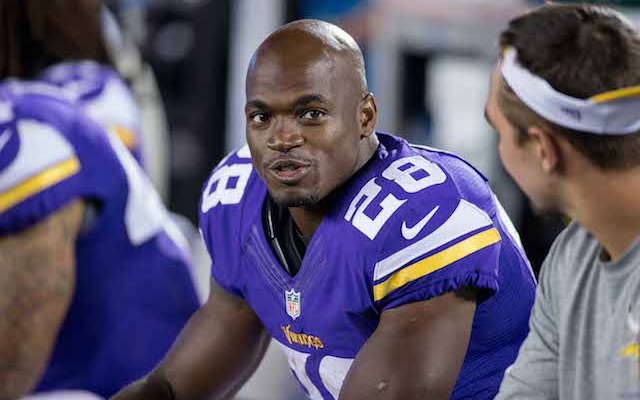
Dogra will want the new contract as front loaded as possible with the 2016 contract year fully guaranteed at signing especially if Peterson has less than the $28 million he is currently scheduled to receive through 2016 is a part of the renegotiation. It’s hard to imagine that he wouldn’t accept a renegotiated deal with $13 million in 2015, $12 million in 2016 ($25 million over two years fully guaranteed at signing), $11 million in 2017 ($36 million over three years) and $10 million in 2018 even though McCoy’s overall guarantees are $1.55 million more and Lynch’s new money average of $12 million per year would be $500,000 more than Peterson’s average salary. The salary cap implications of a renegotiated deal would be largely dependent on the structural conventions with the acquiring team’s contracts (i.e.; amount of signing bonus versus yearly salary guarantees, etc.).
Looking at 7 possible teams for AP
Below are seven teams with either a big need at running back or enough salary cap space to absorb Peterson’s $13 million 2015 salary.
Arizona Cardinals: The Cardinals are reportedly high on Peterson’s list of potential destinations but his existing contract is a major problem. The team recently renegotiated a pay cut with Larry Fitzgerald. He was scheduled to make $16.25 million in 2015 with $61.5 million over the final four years of his deal (through 2018). His renegotiated contract is a fully guaranteed $22 million for two years and contains a no-trade clause.
Any renegotiated deal would include some sort of signing bonus or its equivalent under the salary cap to lower Peterson’s 2015 cap hit since the Cardinals have approximately $13.9 million of cap space. Assuming Peterson’s current salary would be the same in the renegotiated contract, $8 million of cap room would be created if $12 million was converted to signing bonus without tacking on extra years whether real or just for cap purposes.
The addition of Peterson would make the Cardinals a Super Bowl favorite by giving a huge boost to an anemic rushing attack. The Cardinals ranked 31st in rushing with 81.8 yards per game and were last with 3.3 yards for per carry in 2014. The team had a 9-1 record before quarterback Carson Palmer was lost for the season with a torn ACL. Arizona’s second and third round picks are the 55th and 86th overall selections in the draft.
Atlanta Falcons: New head coach Dan Quinn saw the importance of a running game as the Seattle Seahawks’ defensive coordinator during the past two seasons. Kyle Shanahan stated his desire for a workhorse running back shortly after becoming offensive coordinator. 2014 fourth round pick Devonta Freeman sits at the top of the depth chart after Steven Jackson’s release. Peterson would provide some much needed balance to a pass happy offense. The Falcons, who have slightly under $18 million of cap space, are one of four teams to throw at least 600 passes in each of the last three seasons.
There may be reluctance to add another older running back after the two-year Jackson experiment didn’t work out. The Vikings would probably want at least Atlanta’s second round pick, which is 42nd overall, for Peterson.
Dallas Cowboys: Peterson has expressed an interest in playing for the Cowboys before retiring. The Cowboys only had a little less than $2.1 million of cap space before re-signing inside linebacker Rolando McClain. Quarterback Tony Romo creating $12 million of cap room in a contract restructuring helped pave the way for McClain’s return and temporarily gives the Cowboys a little bit of breathing room with the cap. The Cowboys should have in the neighborhood of $11.5 million in cap space after Romo's restructure, which isn't enough for Peterson's 2015 salary. Romo freeing up cap space will fuel rumors that Dallas trading for Peterson is inevitable.
Acquiring Peterson would probably require more flexibility from all parties than a deal to another team. Dallas' cap situation may make a pre-trade contract restructure a necessity even after the Romo restructure. The more of Peterson's salary Minnesota would be willing to be eat, the greater the chance Dallas' first-round pick (27th overall) could be obtained.
The Cowboys might want to address cornerback Brandon Carr's contract if the team is serious about working a trade for Peterson since Pro Bowl defensive end Greg Hardy's one-year deal with a base value of $11,311,600 (worth up to $13.116 million through incentives) complicates matters. Eight million dollars of cap room will be gained by releasing Carr, who is also represented by Dogra, after June 1 or giving him a post-June 1 designation if he is unwilling to take a pay cut.
Hardy currently has a cap charge of $3,217,850 -- $9.25 million of Hardy's deal is in 53-man per game roster bonuses ($578,125 per game). Since Hardy spent two games on the Carolina Panthers' 53-man roster in 2014 before going on the Exempt/Commissioner's Permission List for the rest of the season, only $1,156,250 or two-sixteenths of the roster bonus is currently counting on the cap. The Cowboys will incur a $578,125 cap charge for each game Hardy is on the 53-man roster beginning with his third game. If he's on the 53-man roster for every game, then the team's cap charge for him will have increased by $8,093,750 during the season. Hardy is expected to receive some sort of suspension from the Commissioner because of his domestic violence incident, which will limit the cap increase from his deal.
The Cowboys let Murray walk because they weren’t willing to pay him more than $6 million per year on a multi-year contract. Playing for the Cowboys may require Peterson to accept less than he would from any other team that might be interested in trading for him. Since Peterson was only active for two games with Minnesota before going on the Exempt List like Hardy, Dallas could try to sell him on the same type of roster bonus he has. It’s hard to imagine Dogra entertaining the concept without some sort mechanism allowing Peterson to easily make any money in the roster bonus that wasn’t earned in 2016.
Putting a significant amount of the $13 million Peterson is scheduled to make this year in not likely to be earned (NLTBE) incentives could also be an option that would keep his 2015 cap number low. Any 2015 incentives with higher thresholds than Peterson’s 2014 individual statistical achievements would be classified as NLTBE and wouldn’t count toward the cap until 2016. Peterson has extremely low NLTBE thresholds for this year because he only gained 75 yards on the ground without any rushing touchdowns and had 4.2 percent playtime in 2014. The same problem as with the roster bonus concept would apply to incentives. An injury could prevent Peterson from earning the incentives depending upon how low the thresholds were. This concept wouldn’t get off the ground either with Dogra without a way for Peterson to make the incentive money he didn’t earn in 2016.
Jacksonville Jaguars: Since the Jaguars have a league high $34.95 million in cap space, assuming Peterson’s contract wouldn’t be a problem. The Jaguars pursued Murray before he signed with the Philadelphia Eagles. One of Peterson’s best chances to keep his existing contract intact is with Jacksonville. Prior to the start of free agency, the Jaguars were on track to fall well under the Collective Bargaining Agreement’s requirement that teams spend 89 percent of the salary cap in cash over the four year period of 2013 through 2016. The team’s spending through 2014 was slightly over 82 percent. Jacksonville’s second and third round picks are 36th and 67th overall. If the Jaguars were to make a play for Peterson, they might try to include running back Toby Gerhart, who was a disappointment in 2014 as a free agent signee, in the deal. The Vikings selected him the second round of the 2010 draft.
Oakland Raiders: Peterson nearly broke the NFL’s single season rushing record in 2012 when Oakland’s offensive coordinator Bill Musgrave was in that same position with the Vikings. The Raiders reportedly offered Murray the most money while he was on open the market. This suggests that the Raiders might be one of the most accommodating teams contractually with Peterson. One interesting trade possibility with Peterson could be based around a swap of first round picks where other picks could be included. Minnesota has the 11th overall pick while Oakland has the fourth overall pick. This type of deal would be consistent with Oakland’s first round trade two years ago. A 2013 second round pick (42nd overall) was given to Oakland to move from the third overall pick to the 12th overall pick. The Raiders have a little more than $23 million of cap space.
San Diego Chargers: General manager Tom Telesco gave San Diego’s running backs (Donald Brown, Branden Oliver, and Danny Woodhead) a public vote of confidence at last week’s annual owners meeting. There’s speculation that the Chargers will use their first round pick (17th overall) on a running back despite the affirmation. Acquiring Peterson might prompt Philip Rivers to rethink his stance about playing out his contract, which stems from the team’s potential move from San Diego to Los Angeles. Peterson would also be the five-time Pro Bowl quarterback’s first legitimate feature running back since LaDainian Tomlinson. Peterson’s cap number would need to be lowered because the Chargers have slightly over $15.9 million of cap room. San Diego’s second and third round picks are 48th and 83rd overall.
Tampa Bay Buccaneers: Peterson’s relationship with defensive coordinator Leslie Frazier could be a factor in Peterson reportedly being open to a trade to the Buccaneers. Frazier was a part of Minnesota’s coaching staff, including three-plus years as head coach, during Peterson’s first seven years in the NFL. Cap room isn’t an issue for the Buccaneers. Tampa Bay has the NFL’s fourth most cap space at slightly under $24.5 million. Minnesota acquiring 2012 first round pick Doug Martin (31st overall) as a part of a Peterson trade would be ideal for Tampa Bay. The front office and coaching staff have soured on him. Martin was fifth in the NFL in rushing with 1,454 yards as a rookie in 2012. He’s hasn’t come close to matching his rookie year during the last two years because of ineffectiveness and injury.
Final thoughts
There probably won’t be a quick resolution to Adrian Peterson’s situation if he is still a member of the Vikings after the draft ends on May 2. Peterson would need to decide just how far he is willing to take it to get out of Minnesota since the Vikings might be inclined to wait him out. At this point, it would probably require him skipping offseason activities, extending his absence into the preseason and possibly the regular season for him to get his wish. If Peterson isn’t willing to go these lengths in order to force Minnesota’s hand, it probably makes sense for him to focus on getting the Vikings to modify his existing contract where his $14.75 million 2016 base salary becomes fully guaranteed. The Vikings might be receptive to guaranteeing all or some portion of that season’s salary if the idea is for him to remain the face of the franchise until the new stadium opens at the beginning of the 2016 season.
Joel Corry is a former sports agent who helped found Premier Sports & Entertainment, a sports management firm that represents professional athletes and coaches. Before his tenure at Premier, Joel worked for Management Plus Enterprises, which represented Shaquille O'Neal, Hakeem Olajuwon and Ronnie Lott.
You can follow him on Twitter: @corryjoel
You can email him at jccorry@gmail.com







